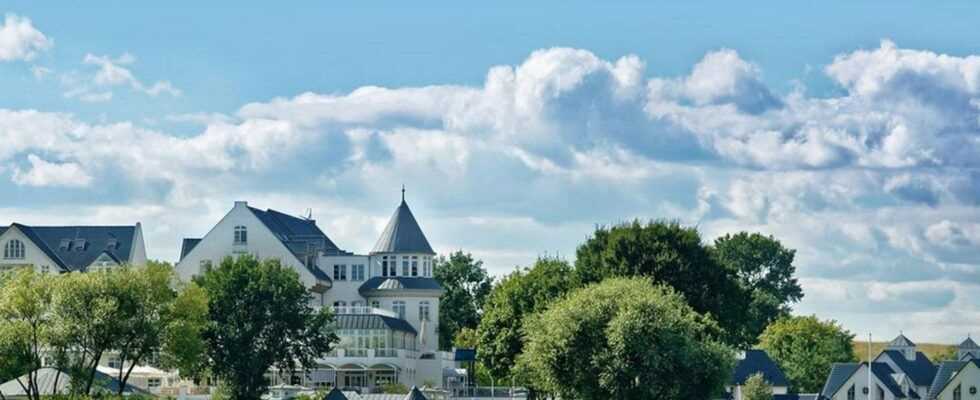Travel to distant countries is currently difficult. Also because of the Corona crisis, the Germans are now discovering the north for themselves.
Mecklenburg Lake District instead of the Mediterranean Sea, Rügen instead of Mallorca, tranquility instead of hustle and bustle. In times of Corona, the Germans also started to rethink their vacation. The current travel restrictions require a little more creativity in vacation planning and show that even the greatest cosmopolitan can learn to appreciate the pearls of their own country. Some of these pearls are in the north. Holiday resorts on the North and Baltic Seas consistently report a very good booking situation. But are the regions prepared for the rush?
Mecklenburg-Western Pomerania: in the land of a thousand lakes
"It always depends on the specific region," says Petra Wolf, company spokeswoman for Precise Hotels. "We have the advantage that the Precise Resorts in Germany are all in the midst of extensive nature with plenty of space and tranquility. In the Schwielowsee resort, holidaymakers can enjoy the forest and lake landscape in the surrounding area. Our guests at the Precise Resort Marina Wolfsbruch in Rheinsberg extensive region of the Mecklenburg Lake District. " There is enough space to avoid other tourists.
Mecklenburg-Western Pomerania has not only been a popular travel destination for Germans since the long Corona dry spell. According to the German Tourism Association, 7.9 million of Germany's domestic vacation trips to Mecklenburg-Western Pomerania were already in 2019. On extended boat, canoe and sailing tours everyone gets their money's worth, who prefer to paddle rather than walk.
Around the Müritz, the largest inner German lake, many sailing schools offer courses for beginners and advanced. If you want to explore the Mecklenburg Lake District on a houseboat without a license, the best thing to do is to make a detour to Fleesensee. Numerous tour suggestions start there. For example, from Untergöhren via Rheinsberg and Plau am See to the state capital of Schwerin.
Green forests and white chalk on Rügen
From there it is not far to the island vacation à la Caspar David Friedrich. Who does not know them, the famous chalk cliffs of Rügen, which the romanticist captured in a painting in 1818? On a hike through the Jasmund National Park, active holidaymakers discover the beauty of the snow-white colossi themselves. From Sassnitz, you take a high-bank path around ten hilly kilometers through the beech forest of the Stubbenkammer to the Königsstuhl. In the end, art and hiking enthusiasts can decide for themselves what is more beautiful: the painted or the real chalk cliffs?
Rügen has become the top holiday paradise of the German coasts in recent years. Petra Wolf also confirms this: "Anyone wishing to secure accommodation here for the summer is well advised to book quickly. We are already very well booked and new visitors come to the island every day." Among other things, they can look forward to a great view from the Granitz hunting lodge. From the middle tower, visitors can see into the Binz Bay. But be careful, the ascent leads over 154 cast-iron, openwork steps to lofty heights – you should be free from giddiness! The "Frenzied Roland" gets you back on track afterwards. The steam locomotive narrow-gauge railway has been chugging across the island since 1895, connecting the well-known seaside resorts of Binz and Göhren. As in all public transport, a mask has been mandatory since the Corona outbreak.
Since May 25th, trips and overnight stays in Mecklenburg-Western Pomerania are again permitted for guests from other federal states. There is one downside, however: According to the Corona Land Ordinance, people are not allowed to enter if they come from an area in which the number of new infections per 100,000 inhabitants was over 50 in the past seven days before entry.
Hiddensee: With the horse across the island
Rügen's beautiful sister Hiddensee is also worth a visit and is only a stone's throw away – she is also called "dat söte Länneken" (the sweet little country). And the lively and open-hearted islanders are right. Anyone who translates from Schaprode to Rügen has a fantastic view of an island that promises peace and relaxation.
There are no annoying horns and deafening howling engines because Hiddensee is car-free. From time to time there is a regular bus, but the best way to discover the island is by bike, on foot or in a horse-drawn carriage. Literary fans can walk in the footsteps of well-known writers and artists such as Gerhart Hauptmann and Asta Nielsen, who found a refuge on Hiddensee and got new inspiration.
Island hopping in Lower Saxony
If you have a taste for it and extend your island feelers a little further, you can consider a holiday in the East Frisian Islands. Spiekeroog, Langeoog, Wangerooge, Pellworm and Amrum were among the first regions to open up to tourism again. Mudflat hikes, for example from Neßmersiel on the East Frisian coast to the island of Baltrum, are possible again under certain conditions and are particularly suitable for a varied family holiday.
Not without my bike!
There is also a lot to discover on the North Sea coast itself. The Lower Saxony Wadden Sea National Park is a UNESCO World Heritage Site and also attracts with guided mudflat hikes and boat tours, where adults and children get to know the water inhabitants. To explore a larger area in and around the national park and biosphere reserve, the bicycle is the mode of transport of choice. Experienced cyclists can take the Tour de Fries, which stretches over 280 kilometers and is divided into six stages. Starting point and destination is Wilhelmshaven.
In Lower Saxony, too, corona restrictions can be expected, about which the state keeps residents and holidaymakers up to date. Nevertheless, nothing stands in the way of a special holiday: Head north!
